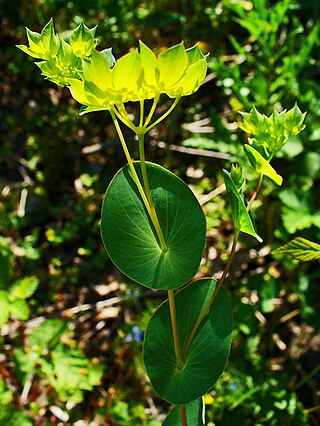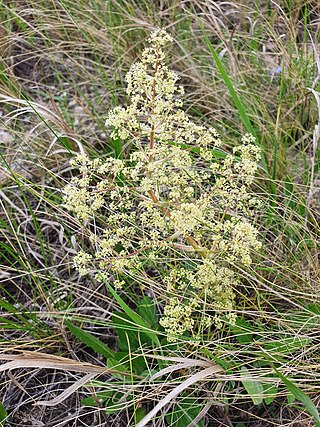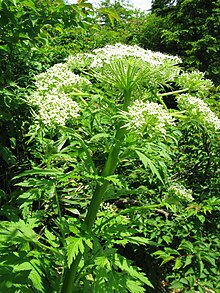
Heracleum is a genus of biennial and perennial herbs in the carrot family Apiaceae. They are found throughout the temperate northern hemisphere and in high mountains as far south as Ethiopia. Common names for the genus or its species include hogweed and cow parsnip.

Sebastiania is a genus of flowering plants in the family Euphorbiaceae first described in 1821. It is native to North and South America from Arizona and the West Indies south to Uruguay.

Macaranga is a large genus of Old World tropical trees of the family Euphorbiaceae and the only genus in the subtribe Macaranginae. Native to Africa, Australasia, Asia and various islands of the Indian and Pacific Oceans, the genus comprises over 300 different species. It was first described as a genus in 1806, based on specimens collected on the Island of Mauritius.

Bupleurum is a large genus of annual or perennial herbs or woody shrubs, with about 190 species, belonging to the family Apiaceae. The full size of its species may vary between a few cm to up to 3 m high. Their compound umbels of small flowers are adorned with bracteoles that are sometimes large and may play a role in attracting pollinators. Rare among the Apiaceae are the simple leaves, bracts, and bracteoles. The genus is almost exclusively native in the Old World Northern Hemisphere, with one species native to North America and one species native to southern Africa.

Emilia is a genus of herbaceous plants in the family sunflower family, known as tasselflower or pualele.

Conioselinum is a genus of flowering plant in the family Apiaceae, native to Eurasia and North America. Its species are erect perennial plants with deeply toothed compound leaves and umbels of white flowers. Plants of this genus are known commonly as hemlock-parsley.

Dicoma is a genus of flowering plants in the family Asteraceae, native to Africa and the Middle East.
Karl August Otto Hoffmann was a German botanist and a high school teacher in Berlin. Author of Sertum plantarum madagascariensium, the genus Hoffmanniella in the family Asteraceae was named after him by Rudolf Schlechter. The plant genus of Hoffmannanthus (also in the family of Asteraceae was named after him in 2014.

Turgenia is a genus of flowering plants in the family Apiaceae, containing up to seven species. The genus resembles Caucalis. False carrot is a common name for plants in this genus.
Lepisorus squamatus is a species of fern known only from Vietnam and from Guangxi Province in southern China. The plant is herbaceous, spreading by rhizomes. The leaves are simple, elliptical, and the sori are round, on the underside of the leaves. The spores are white.

Heterosavia is a genus of the family of Phyllanthaceae first described as a genus in 2008. It is native to the Caribbean and southern Florida. It is found in Bahamas, Cayman Islands, Cuba, Dominican Republic, Florida, Haiti, Jamaica, southwest Caribbean and Turks-Caicos Islands.
Orbivestus is a genus of shrubs in the family Asteraceae, native to tropical Africa, the Arabian Peninsula and the Indian subcontinent. Its species were formerly placed in the genus Vernonia.
Namibithamnus is a genus of flowering plants belonging to the family Asteraceae.
Ostericum is a genus of flowering plants belonging to the family Apiaceae.
Pternopetalum is a genus of flowering plants belonging to the family Apiaceae.
Lampropappus is a genus of flowering plants belonging to the family Asteraceae.
Hoffmannanthus is a monotypic genus of flowering plants in the Asteraceae. There is only one known species, Hoffmannanthus abbotianus(O.Hoffm.) H.Rob., S.C.Keeley & Skvarla Its native range is Uganda and southern Tropical Africa. It is found in the countries of Angola, Kenya, Tanzania, Uganda, Zambia and Zaïre.

Trinia is a genus of flowering plants in the family Apiaceae, native from Europe to Iran and western Siberia. The genus was first described by Georg Franz Hoffmann in 1814.










